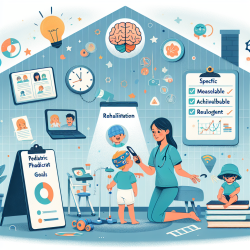Empowering Pediatric Practitioners: Implementing CICI for Better Rehabilitation Outcomes

The "Feasibility and Acceptability of a Complex Telerehabilitation Intervention for Pediatric Acquired Brain Injury: The Child in Context Intervention (CICI)" study offers significant insights for practitioners aiming to enhance rehabilitation outcomes for children with acquired brain injury (ABI). The study emphasizes a multidisciplinary, goal-oriented approach delivered primarily through videoconferencing, targeting physical, cognitive, behavioral, social, and psychological challenges. Here, we discuss key takeaways from the study and how they can be implemented to improve clinical practice.
Key Findings and Implementation Strategies
1. Individualized, Goal-Oriented Rehabilitation
The CICI study highlights the effectiveness of individualized, SMART-goal (Specific, Measurable, Achievable, Realistic/Relevant, and Timed) based rehabilitation. Practitioners can adopt this approach by:
- Collaborating with families to set specific and meaningful goals.
- Using Goal Attainment Scaling (GAS) to measure progress.
- Incorporating the child's input in goal-setting to ensure relevance and motivation.
2. Feasibility of Telerehabilitation
The study found that delivering rehabilitation via videoconference is feasible and acceptable to families. To integrate telerehabilitation effectively:
- Ensure robust technical support and secure, user-friendly platforms.
- Train therapists in using telehealth tools and maintaining engagement through virtual sessions.
- Provide families with necessary equipment and guidance on optimizing their home environment for therapy.
3. Involving Schools in Rehabilitation
Involving the child's school in the rehabilitation process proved beneficial. Practitioners should:
- Engage with educators to align therapy goals with academic needs.
- Conduct regular meetings with school staff to monitor and adapt strategies.
- Facilitate communication between the school, family, and therapy team to ensure a cohesive approach.
4. Addressing Assessment Burden
The study noted that the assessment burden was high, suggesting the need for streamlined protocols. Practitioners can:
- Use brief, validated tools to assess key areas such as symptom burden, quality of life, and parenting self-efficacy.
- Prioritize assessments that directly inform goal-setting and intervention planning.
- Consider the child's cognitive and emotional state when conducting assessments to minimize fatigue and frustration.
Encouraging Further Research
While the CICI study provides a solid foundation, further research is needed to explore long-term outcomes and refine intervention strategies. Practitioners are encouraged to:
- Participate in ongoing research initiatives and clinical trials.
- Share findings and best practices within the professional community.
- Advocate for funding and support for pediatric ABI rehabilitation research.
To read the original research paper, please follow this link:
Feasibility and Acceptability of a Complex Telerehabilitation Intervention for Pediatric Acquired Brain Injury: The Child in Context Intervention (CICI).
Citation: Holthe, I. L., Rohrer-Baumgartner, N., Svendsen, E. J., Hauger, S. L., Forslund, M. V., Borgen, I. M. H., Øra, H. P., Kleffelgård, I., Strand-Saugnes, A. P., Egeland, J., Røe, C., Wade, S. L., & Løvstad, M. (2022). Feasibility and Acceptability of a Complex Telerehabilitation Intervention for Pediatric Acquired Brain Injury: The Child in Context Intervention (CICI). Journal of Clinical Medicine, 11(9), 2564. https://doi.org/10.3390/jcm11092564










